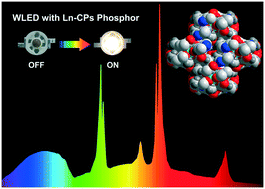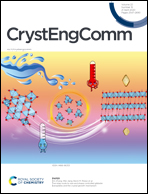Highly chemically and thermally stable lanthanide coordination polymers for luminescent probes and white light emitting diodes†
Abstract
A series of isomorphic lanthanide coordination polymers with 2,6-dimethylpyridine-3,5-dicarboxylic acid (H2mpda), formulated as [Ln(Hmpda)3(H2mpda)] [Ln = Tb (1), Eu (2), Gd (3) and Ln = mixed lanthanide (4)], have been synthesized and structurally characterized. Single-crystal X-ray diffraction reveals that they are isomorphic and each displays a 1D chain-based structure, which can be expanded by hydrogen bond interactions into a 3D supramolecular architecture. In addition, they are thermally stable up to 350 °C and unusually chemically stable in a wide pH range of 2–13, which was confirmed by variable temperature XRD and pH dependent XRD. Meanwhile, the luminescence properties of compounds 1–4 are investigated. Of these, compound 1 acts as a luminescent probe for the sensing of temperature and pH, and compound 4 shows white light emission. Moreover, compounds 1, 2 and 4 were encapsulated in LED devices, with compound 4 exhibiting warm white light emission with excellent color rendering index (CRI) and correlated color temperature (CCT).



 Please wait while we load your content...
Please wait while we load your content...